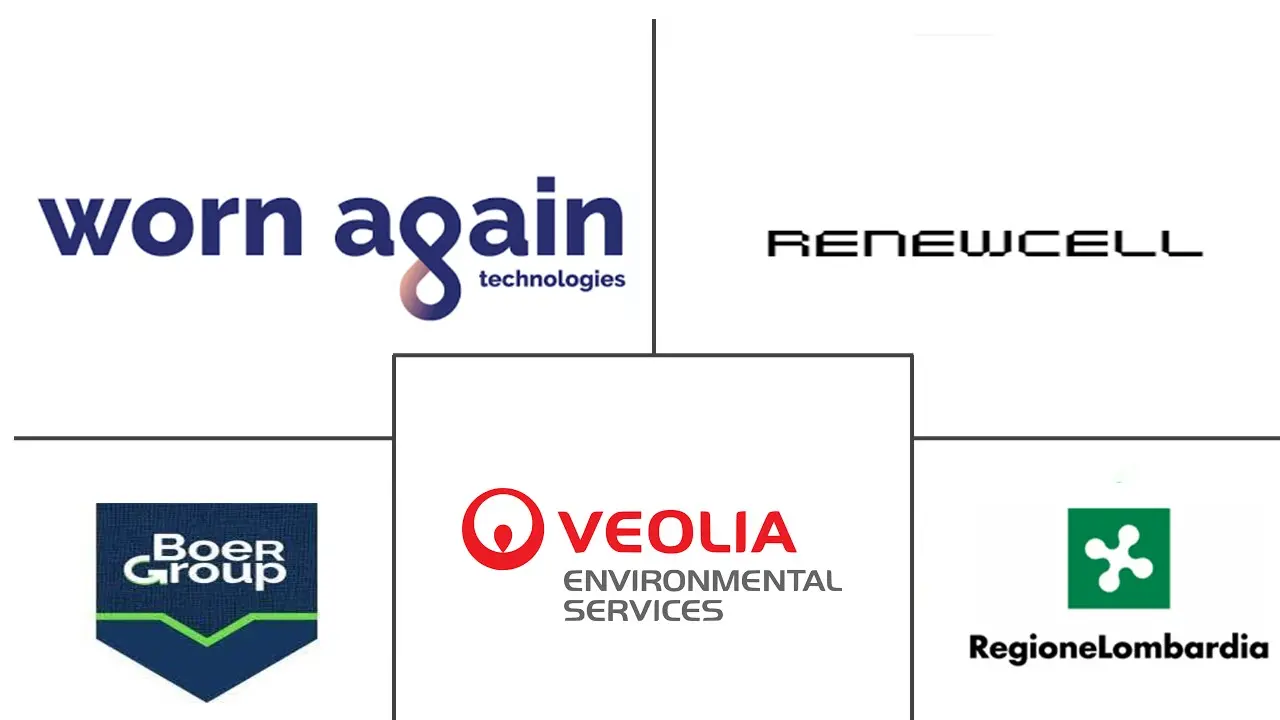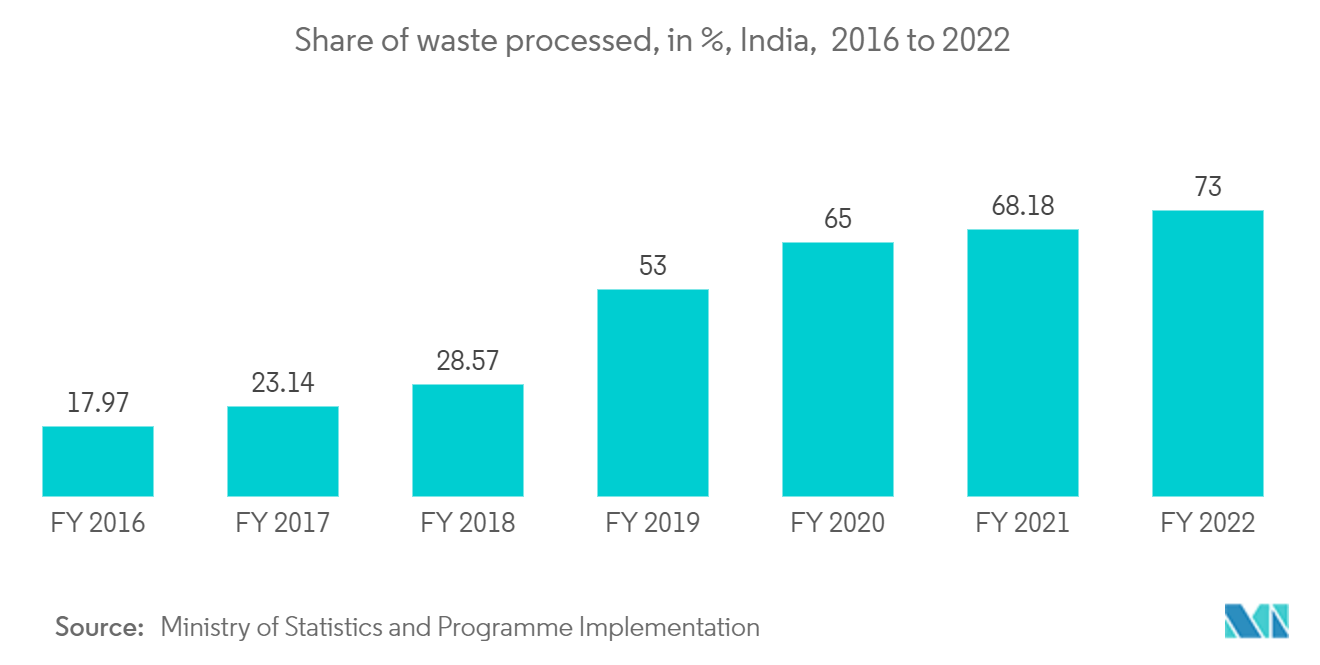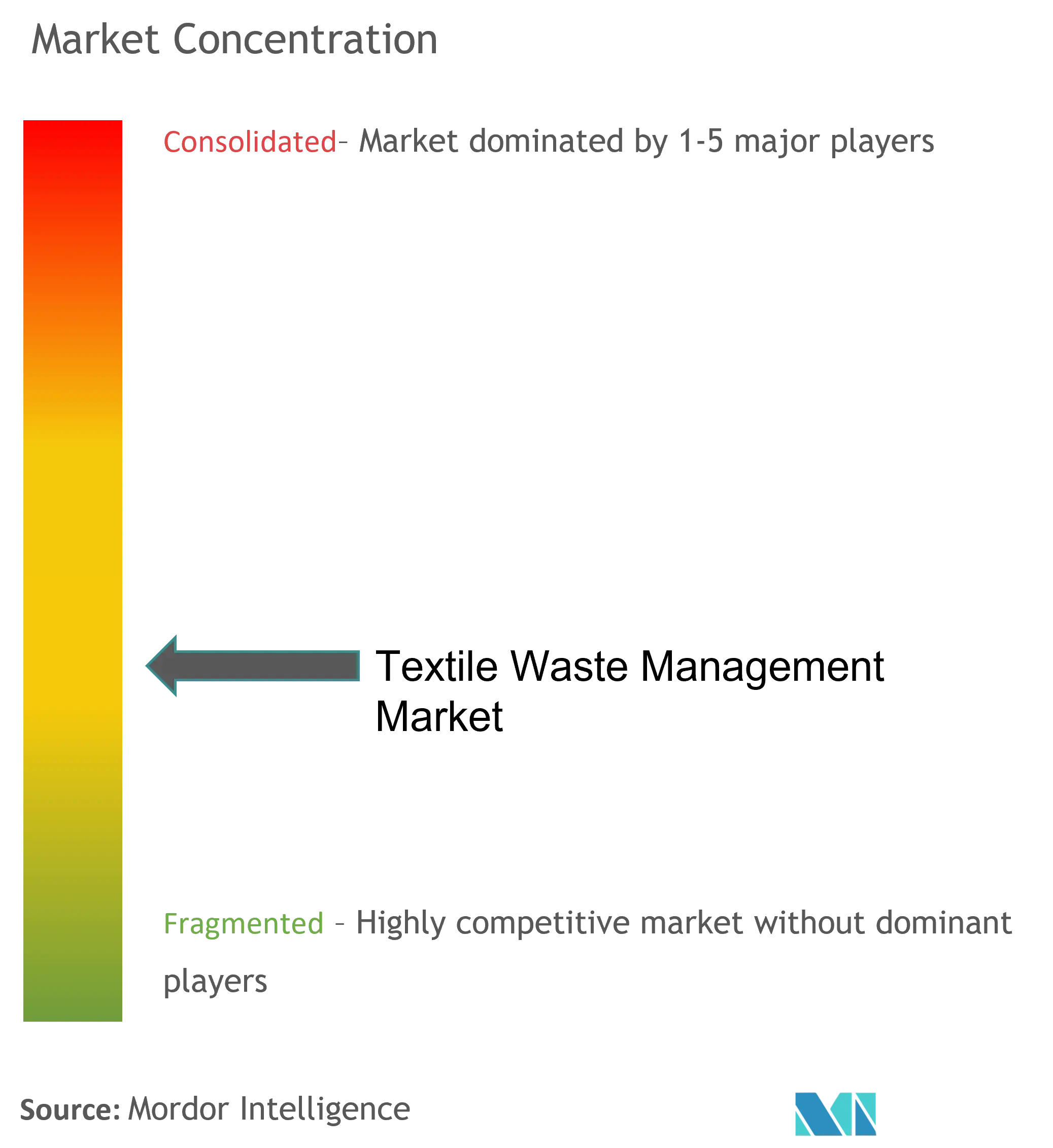Textile Waste Management Market Size

| Study Period | 2019 - 2029 |
| Base Year For Estimation | 2023 |
| CAGR | 3.00 % |
| Fastest Growing Market | Asia-Pacific |
| Largest Market | Europe |
| Market Concentration | Low |
Major Players
*Disclaimer: Major Players sorted in no particular order |
Textile Waste Management Market Analysis
The Textile Waste Management Market is expected to register a CAGR of over 3% during the forecast period.
- The textile recycling market is expected to grow because people are becoming more aware of recycling and because they care more about the environment.Furthermore, the COVID-19 pandemic had a detrimental influence on worldwide market growth. The textile recycling industry is facing a setback due to constraints and impediments to executing the pre-recycling process.
- As a result, garments and textiles are stacked up in warehouses, slowing market development. Various initiatives and start-ups are gaining traction in the United States, contributing considerably to the rising rate of textile recycling. ATRS (American Textile Recycling Services) is the donation bin operator for clothes, footwear, and household items donation and collection services. ARTS is constantly extending to new locations around the country, accelerating the expansion of recycling.
- Furthermore, advancements in recycling procedures and new research in the industry are expected to aid market expansion. For example, at the International Conference on Cellulose Fibers in February 2022, LIST Technology AG presented an all-recycled lyocell t-shirt as a major step forward in the textile recycling business. The restricted availability and accessibility of sufficient recyclable material severely limits market expansion. Most of the time, the fabric material is combined, making the sorting procedure and subsequent recycling difficult. Additionally, informal vendors carry out the collecting and sorting process in less developed countries, which has an impact on the overall recycling rate and market expansion.
Textile Waste Management Market Trends
This section covers the major market trends shaping the Textile Waste Management Market according to our research experts:
The Polyester Recycling Industry Is Predicted To Grow At A Rapid Pace
Polyester recycling is picking up speed because there is more demand for it in the fashion industry. Companies have promised to use more recycled polyester in clothes by replacing regular polyester.The majority of polyamide recycling is done using nylon, and the majority of the recycling is done using the chemical recycling method. The nylon recycling process is filled with technological difficulties, and there are now just a few businesses that recycle nylon. Polyamide used for recycling comes mostly from used fabric, but it can also come from things like fishing nets that have already been used.
And in December 2022, scientists at the National Renewable Energy Laboratory (NREL) in the United States found enzymes that might make recycling waste polyester fabrics and bottles cheaper than producing them from petroleum. Researchers at NREL came up with different enzymes that can break down all types of polyethylene terephthalate (PET), even the kind that lasts a long time and is crystalline.
When polyester waste is taken away, it is possible to make polyester yarn from recycled PET. This yarn has the same properties as first-process polyester, so it uses less energy to make new things. Polyester trash recycling not only reduces energy consumption and eliminates plastic waste dispersion in the environment, but it also saves money on subsequent manufacturing and high-quality goods.

Asia Pacific Region Dominated The Global Textile Waste Management Industry
Regional market growth is helped by upcoming new projects and plans by the Indian government to set up integrated textile parks. Also, more textiles are being sent to places like the U.S. and Europe, and the fact that China, India, Bangladesh, and Vietnam are important textile countries makes the market more likely to grow. Also, wastewater treatment plants dominated a part of the market for managing textile waste, and they are likely to continue to do so over the next four years. The need to address environmental concerns about water shortages and the loss of clean water supplies around the world is what is driving the growth of this industry.
The Asia-Pacific market is also getting a boost from the creation of eco-clothes made from recycled fabrics, plastics, and other organic raw materials. Aside from that, the popularity of door-to-door clothing pickup and the installation of clothing collection bins in public places are key growth drivers. And the market is growing because more people are choosing house materials because they are comfortable and have other benefits. Moreover, the Asia-Pacific textile recycling market is expected to grow over the next few years as leading companies create new technologies for automated sorting applications.

Textile Waste Management Industry Overview
The market is broken up because recycled textiles are being used in more and more consumer sectors to help make other products.End-user demand has created strong competition in the industry, resulting in industrial fragmentation. The Infinited Fiber Company (IFC) has invested much in textile recycling. The firm recently gained backing from well-known manufacturers to develop its recycling technology, including H&M Group, RGE Pte Ltd., Virala, and Singapore-based Fortum.
The global textile waste management industry is projected to invest in innovative technologies. Furthermore, the success of these suppliers is heavily reliant on their willingness to accept raw production. Worn Again Technologies, Re:NewCell, and Pistoni S.r.l. are a few of the industry's significant players.
Textile Waste Management Market Leaders
-
Worn Again Technologies
-
Veolia Environnement S.A.
-
Boer Group
-
Re:NewCell
-
Pistoni S.r.l
*Disclaimer: Major Players sorted in no particular order

Textile Waste Management Market News
January 2023: Re:NewCell, a Swedish company that recycles cellulosic textile waste and turns it into Circulose material, sent the first batch of dissolving pulp made at its new Renewcell 1 factory in Sundsvall, a Swedish city about 230 miles north of Stockholm, to a client. The deal is the most recent step toward the initial capacity of 60,000 tons per year for the facility.
November 2022: Renewcell of Sweden has entered into a new partnership arrangement with Eastman, a prominent US cellulosic acetate fiber producer, to develop Naia Renew ES yarns based on Circulos 100% recycled textile raw material. This is Renewcell's first partnership with a US-based fiber producer, and it is a key step toward building the first acetate-based products that will employ Circulose feedstock.
June 2022: Worn Again Technologies has launched the Swiss Textile Recycling Ecosystem, which the company claims is a significant step forward in the development of its recycling process technology. The Swiss Textile Recycling Ecosystem is an interconnected network of fabric and textile producers, waste collectors and sorters, merchants, brand owners, and technology suppliers. The partners will supply various types of textile waste to WAT's demonstration facility, which will process 1,000 tons of material per year and is being built near Sulzer Chemtech, a technology scale-up partner.
Textile Waste Management Market Report - Table of Contents
1. INTRODUCTION
- 1.1 Study Deliverables
- 1.2 Study Assumptions
- 1.3 Scope of the Study
2. RESEARCH METHODOLOGY
3. EXECUTIVE SUMMARY
4. MARKET INSIGHTS AND DYNAMICS
- 4.1 Market Overview
- 4.2 Market Drivers
- 4.3 Market Restraints/Challenges
- 4.4 Market Opportunities
- 4.5 Value Chain/Supply Chain Analysis
-
4.6 Porter's Five Forces Analysis
- 4.6.1 Threat of New Entrants
- 4.6.2 Bargaining Power of Buyers/Consumers
- 4.6.3 Bargaining Power of Suppliers
- 4.6.4 Threat of Substitute Products
- 4.6.5 Intensity of Competitive Rivalry
- 4.7 Technological Innovations in the industry
- 4.8 Government Initiatives to Attract Investment in the Industry
- 4.9 Impact of COVID - 19 on the Industry
5. MARKET SEGMENTATION
-
5.1 By Waste
- 5.1.1 Hazardous
- 5.1.2 Plastic
- 5.1.3 Polyester
- 5.1.4 Other Wastes
-
5.2 By Service
- 5.2.1 Open dumping
- 5.2.2 Incineration
- 5.2.3 Landfil
- 5.2.4 Recycling
-
5.3 By End-User
- 5.3.1 Residential
- 5.3.2 Commercial
- 5.3.3 Industrial
- 5.3.4 Other End-Users
-
5.4 By Geography
- 5.4.1 North America
- 5.4.1.1 United States
- 5.4.1.2 Canada
- 5.4.1.3 Mexico
- 5.4.2 Europe
- 5.4.2.1 Germany
- 5.4.2.2 France
- 5.4.2.3 United Kingdom
- 5.4.2.4 Italy
- 5.4.2.5 Spain
- 5.4.2.6 Russia
- 5.4.2.7 Rest of Europe
- 5.4.3 Asia-Pacific
- 5.4.3.1 China
- 5.4.3.2 Japan
- 5.4.3.3 India
- 5.4.3.4 Bangladesh
- 5.4.3.5 Turkey
- 5.4.3.6 South Korea
- 5.4.3.7 Australia
- 5.4.3.8 Indonesia
- 5.4.3.9 Rest of Asia-Pacific
- 5.4.4 Middle East & Africa
- 5.4.4.1 Egypt
- 5.4.4.2 South Africa
- 5.4.4.3 Saudi Arabia
- 5.4.4.4 Rest of Middle East & Africa
- 5.4.5 South America
- 5.4.5.1 Brazil
- 5.4.5.2 Argentina
- 5.4.5.3 Rest of South America
6. COMPETITIVE LANDSCAPE
- 6.1 Market Concentration Overview
-
6.2 Company Profiles
- 6.2.1 Worn Again Technologies
- 6.2.2 Veolia Environnement S.A.
- 6.2.3 Boer Group
- 6.2.4 Re:NewCell
- 6.2.5 Pistoni S.r.l
- 6.2.6 Lenzing AG
- 6.2.7 Textile Recycling International
- 6.2.8 RE TEXTIL Deutschland GmbH
- 6.2.9 Hyosung Group
- 6.2.10 Infinited Fiber Company*
- *List Not Exhaustive
7. MARKET OPPORTUNITIES AND FUTURE TRENDS
8. APPENDIX
- 8.1 GDP Distribution, by Activity
- 8.2 Insights on Capital Flows
Textile Waste Management Industry Segmentation
Waste management in the textile industry is defined as the procedures and actions needed to control waste from start to finish. This covers trash collection, transportation, treatment, and disposal, as well as waste management process monitoring and control. It also covers waste-related legislation, technology, and economic systems.
The textile waste management market is segmented by waste (hazardous, plastic, polyester, others), service (open dumping, incinerating, landfilling, recycling), end-user (residential, commercial, industrial, others), and geography (North America, Asia-Pacific, Europe, the Middle East and Africa, and South America).
The report offers market size and forecast values (in USD billions) for all the above segments. The report also covers the impact of COVID-19 on the market.
| By Waste | Hazardous | |
| Plastic | ||
| Polyester | ||
| Other Wastes | ||
| By Service | Open dumping | |
| Incineration | ||
| Landfil | ||
| Recycling | ||
| By End-User | Residential | |
| Commercial | ||
| Industrial | ||
| Other End-Users | ||
| By Geography | North America | United States |
| Canada | ||
| Mexico | ||
| By Geography | Europe | Germany |
| France | ||
| United Kingdom | ||
| Italy | ||
| Spain | ||
| Russia | ||
| Rest of Europe | ||
| By Geography | Asia-Pacific | China |
| Japan | ||
| India | ||
| Bangladesh | ||
| Turkey | ||
| South Korea | ||
| Australia | ||
| Indonesia | ||
| Rest of Asia-Pacific | ||
| By Geography | Middle East & Africa | Egypt |
| South Africa | ||
| Saudi Arabia | ||
| Rest of Middle East & Africa | ||
| By Geography | South America | Brazil |
| Argentina | ||
| Rest of South America |
Textile Waste Management Market Research FAQs
What is the current Textile Waste Management Market size?
The Textile Waste Management Market is projected to register a CAGR of greater than 3% during the forecast period (2024-2029)
Who are the key players in Textile Waste Management Market?
Worn Again Technologies, Veolia Environnement S.A., Boer Group, Re:NewCell and Pistoni S.r.l are the major companies operating in the Textile Waste Management Market.
Which is the fastest growing region in Textile Waste Management Market?
Asia-Pacific is estimated to grow at the highest CAGR over the forecast period (2024-2029).
Which region has the biggest share in Textile Waste Management Market?
In 2024, the Europe accounts for the largest market share in Textile Waste Management Market.
What years does this Textile Waste Management Market cover?
The report covers the Textile Waste Management Market historical market size for years: 2019, 2020, 2021, 2022 and 2023. The report also forecasts the Textile Waste Management Market size for years: 2024, 2025, 2026, 2027, 2028 and 2029.
Textile Waste Management Industry Report
Statistics for the 2024 Textile Waste Management market share, size and revenue growth rate, created by Mordor Intelligence™ Industry Reports. Textile Waste Management analysis includes a market forecast outlook to 2029 and historical overview. Get a sample of this industry analysis as a free report PDF download.



